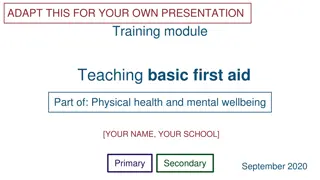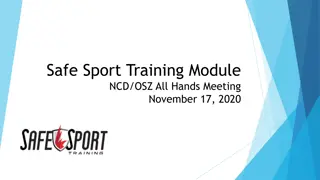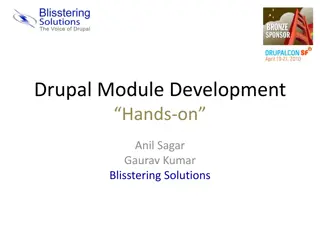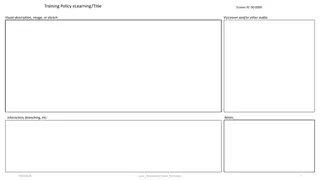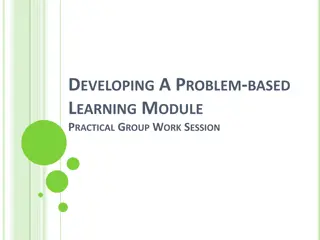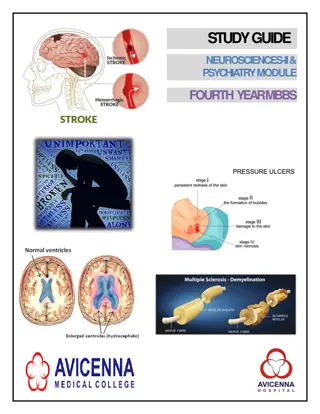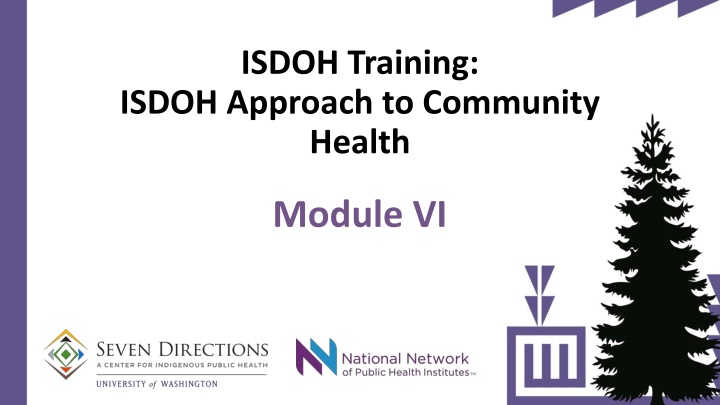
Indigenous Social Determinants of Health and Public Health Practice
Explore the unique and shared Indigenous social determinants of health, their impact on communities, and how they inform public health practice. Learn about the connections between social determinants, Indigenous populations, and community health in this informative module.
Uploaded on | 0 Views
Download Presentation

Please find below an Image/Link to download the presentation.
The content on the website is provided AS IS for your information and personal use only. It may not be sold, licensed, or shared on other websites without obtaining consent from the author. If you encounter any issues during the download, it is possible that the publisher has removed the file from their server.
You are allowed to download the files provided on this website for personal or commercial use, subject to the condition that they are used lawfully. All files are the property of their respective owners.
The content on the website is provided AS IS for your information and personal use only. It may not be sold, licensed, or shared on other websites without obtaining consent from the author.
E N D
Presentation Transcript
ISDOH Training: ISDOH Approach to Community Health Module VI
Purpose and Learning Objectives Purpose: This module examines how an ISDOH framework can inform public health, behavioral health, health, and social services. Learning Objectives: Develop definitions of SDOH and ISDOH that are community specific. Identify the connections between SDOH and ISDOH. Describe ways these new understandings can inform public health practice.
Review Module I: Explored major events that shaped who you are in the adapted River of Life activity Module II: Defined SDOH important to your community compared to CDC domains Module III: Helped to map the ISDOH in your community Module IV: Applied structural determinants of health through a tribal community example Module V: Examined systemic determinants and approaches to address them in tribal settings Module VI: Apply the SDOH and ISDOH identified in your community to public health practice
Types of Indigenous Social Determinants of Health Indigenous Social Determinants of Health may be classified as broad, unique, or shared (Carroll et al., 2022). Broad social determinants are those held in common across all populations. For example, access to clean drinking water is a determinant of health common to all humans. These determinants include the conditions all humans experience in their daily lives that relate to opportunities for healing, health, and wellness. Adapted from Determinants of Collective Health and well-being in U.S. Indigenous communities (Carroll, et al., 2022, p.7).
Unique Indigenous Social Determinants of Health Unique Indigenous Social Determinants are those specific to tribal or urban Indian populations. For example, if only one tribal community held a particular spiritual belief that is related to health behaviors, that would be unique as no other community holds it. Discuss: What are examples of unique Indigenous social determinants of health from your community? Adapted from Determinants of Collective Health and well-being in U.S. Indigenous communities (Carroll, et al., 2022, p.7).
Shared Indigenous Social Determinants of Health Shared Indigenous Social Determinants of Health refers to factors that are held in common across American Indian and Alaska Native communities. These could include: federal, state, or tribal legislation policies and practices developed in response to colonization / settler colonialism boarding school attendance extraction of natural resources within tribal jurisdictions or in sacred / traditional territories access to Indian Health Service Discuss: What are examples of shared Indigenous social determinants of health from your community? Adapted from Determinants of Collective Health and well-being in U.S. Indigenous communities (Carroll, et al., 2022, p.7).
Applying SDOH and ISDOH in Community Practice Refer to "Module VI, Part 1" worksheet Activity 1 Identify & Define Community-Specific SDOH & ISDOH Step 1: Create a list of SDOH and ISDOH for your setting. Gather diagrams, lists, and summaries from Module I: Our Stories, Our Journeys; Module II: Social Determinants of Health; Module III: Indigenous Social Determinates of Health; Module IV Structural Determinants; and Module V: Systemic Determinants. Break into five groups and assign a module to each group. Review, discuss, and list ISDOH that are unique only to your community. (15 minutes) Which ISDOH do your community share with other Indigenous communities? (15 minutes) Identify determinants or factors that fall into the broad determinants of health. (15 minutes) Share your lists in the larger group. Which ones are the same? Which are different?
Applying ISDOH in Community Practice Place the ISDOH identified within the following three areas: Activity 1 Identify & Define Community Specific ISDOH 1. Indigenous Social Determinants of Health (Unique) 2. Indigenous Social Determinants of Health (Shared) 3. Social Determinants of Health (Broad) Step 2: Categorize the ISDOH you identified On a large whiteboard or using post-it notes, draw the three circles and label them. In small groups, review the list and discuss where they would be placed. This will support making connections between SDOH and ISDOH and describing them with community members in the next activity.
Applying ISDOH in Community Practice Activity 2 Making the connections between ISDOH and Community Health Perceptions Hearing community perspectives at different points in the process can help triangulate ISDOH patterns and identify priorities. Let's say you plan to hold community discussions about these determinants. What are some approaches to synthesizing community stories / lived experiences to clarify ISDOH? How can community meetings help confirm and/or expand the list of ISDOH? How could this process result in a community-specific ISDOH framework? What would this type of framework be useful for?
Post-Module Reflection What were your thoughts about the differences among Unique, Shared, and Broad Determinants of Health and how they apply to your community? How has your perspective shifted AFTER this module, if at all? How will you apply this information to your current work? Can you identify some things you will do differently after participating in this module?
Summary This module offered attendees an opportunity to review the past five modules to establish community-specific definitions of ISDOH. We then mapped connections between the important ISDOH to better understand how they relate to community health. This can help identify how tribal and urban Indian programs might be developed to best address ISDOH most relevant to community health. Prioritizing the key ISDOH and identifying concrete goals of how to include ISDOH in existing programming will assist attendees to tailor their efforts to specific community health needs.
Bibliography Carroll, S. R., Suina, M., J ger, M. B., Black, J., Cornell, S., Gonzales, A. A., ... & Teufel-Shone, N. I. (2022). Reclaiming Indigenous Health in the US: moving beyond the Social Determinants of Health. International journal of environmental research and public health, 19(12), 7495.
Citation Parker, M., Largo, D., Benally, T., Or , C.E. (2023). Indigenous social determinants of health: training modules. University of Washington: Seven Directions. [link to website pdf]
Acknowledgments This project is supported by the Centers for Disease Control and Prevention (CDC) of the U.S. Department of Health and Human Services (HHS) as part of a financial assistance award to the National Network of Public Health Institutes (NNPHI) totaling $375,000 with 100 percent funded by CDC/HHS (Award #s 1 NU38OT000303-01-00, 5 NU38OT000303-04-00, and 5 NU38OT000303-03-00). NNPHI has collaborated with Seven Directions at the University of Washington, and the CDC s Office of Tribal Affairs and Strategic Alliances, on this effort.





